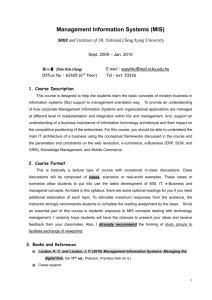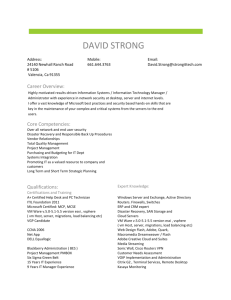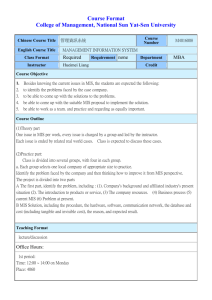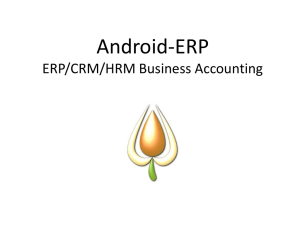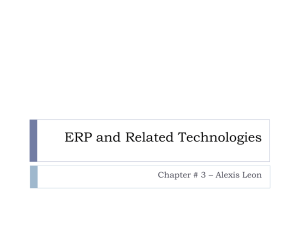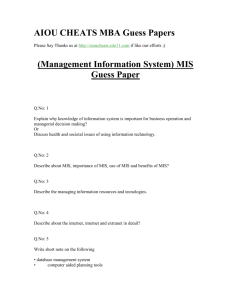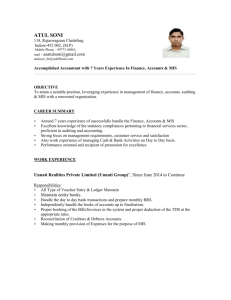MIS 2101_section 6 schedule_Spring2016
advertisement
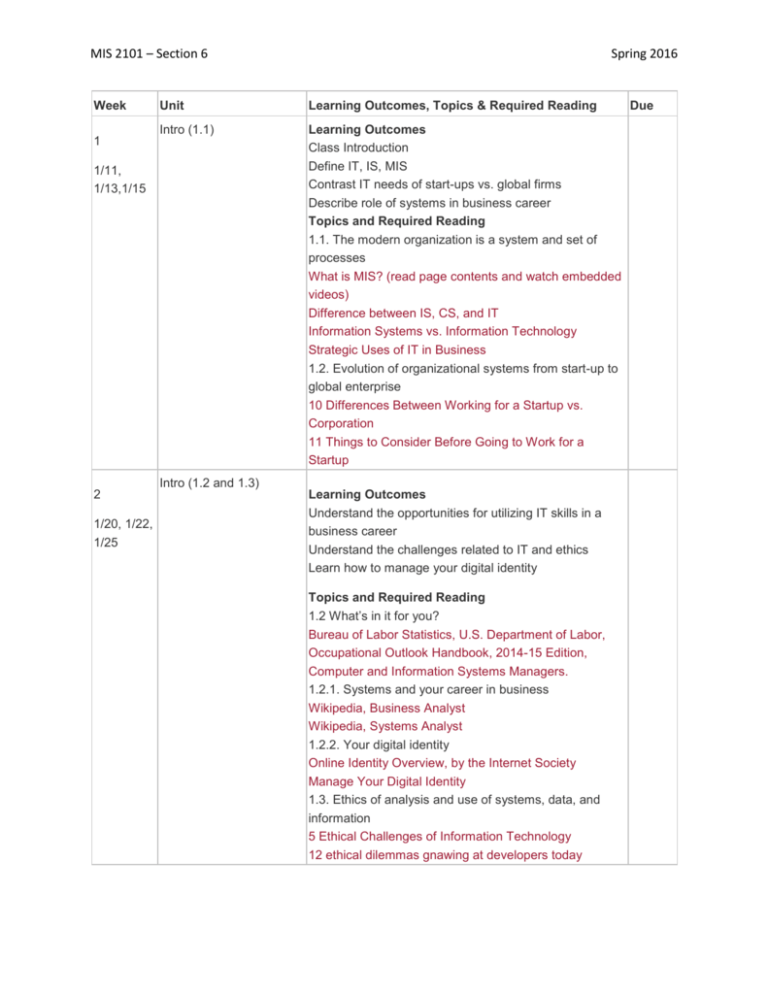
MIS 2101 – Section 6 Week 1 Unit Learning Outcomes, Topics & Required Reading Intro (1.1) Learning Outcomes Class Introduction Define IT, IS, MIS Contrast IT needs of start-ups vs. global firms Describe role of systems in business career Topics and Required Reading 1.1. The modern organization is a system and set of processes What is MIS? (read page contents and watch embedded videos) Difference between IS, CS, and IT Information Systems vs. Information Technology Strategic Uses of IT in Business 1.2. Evolution of organizational systems from start-up to global enterprise 10 Differences Between Working for a Startup vs. Corporation 11 Things to Consider Before Going to Work for a Startup 1/11, 1/13,1/15 2 1/20, 1/22, 1/25 Spring 2016 Intro (1.2 and 1.3) Learning Outcomes Understand the opportunities for utilizing IT skills in a business career Understand the challenges related to IT and ethics Learn how to manage your digital identity Topics and Required Reading 1.2 What’s in it for you? Bureau of Labor Statistics, U.S. Department of Labor, Occupational Outlook Handbook, 2014-15 Edition, Computer and Information Systems Managers. 1.2.1. Systems and your career in business Wikipedia, Business Analyst Wikipedia, Systems Analyst 1.2.2. Your digital identity Online Identity Overview, by the Internet Society Manage Your Digital Identity 1.3. Ethics of analysis and use of systems, data, and information 5 Ethical Challenges of Information Technology 12 ethical dilemmas gnawing at developers today Due MIS 2101 – Section 6 3 Systems analysis (2.1) 1/27, 1/29, 2/1 4 Systems analysis (2.2) 2/3, 2/5, 2/8 Spring 2016 Learning Outcomes Prepare a swim lane diagram for a multi-step process Prepare a simple entity relationship diagram Topics and Required Reading 2.1. Analyzing organizations as systems and processes Wikipedia, Systems Analysis Systems architecture Systems Architecture Fundamentals – Conceptual, Logical, Physical Designs 2.1.1. Process decomposition: swimlane diagrams A Guide to Process Mapping An Introduction to Swimlane Diagrams 2.1.2. Data modeling: entity relationship diagrams Nishadha. Ultimate Guide to ER Diagrams Entity Relationship Diagram Examples Learn IT! #1 Due 1/27 Learning Outcomes Interpret a conceptual architecture diagram Understand the basics of how the Internet works Topics and Required Reading 2.2. Systems architecture: devices, network, data, apps 2.2.1. Visualizing architecture: conceptual diagramming Concept map What is a Concept Map? Investigative Architecture: The Conceptual Diagram 2.2.2. How the Internet works How does the internet work? – James May’s Q&A There and Back Again: A Packet’s Tale – How does the Internet work? How the Internet Works 5 Midterm Exam Midterm Exam #1 – Assess week 1-4 learning objectives, February 15 2,10, 2/12, 2/15 (test) 6 2/17, 2/19, 2/22 Midterm Preparation Organizational Systems (3.) Learning Outcomes Match business functions with organizational IS Discuss major functions of an ERP Topics and Required Reading 3.1. Types of systems in organizations Learn IT! #2 Due 2/12 MIS 2101 – Section 6 Spring 2016 3.1.1. Running the business: enterprise systems (ERP) What Is ERP? Wikipedia: ERP Putting the Enterprise into the Enterprise System 9 Tips for Selecting and Implementing an ERP System 7 Organizational Systems (3.1) 2/24, 2/26, 3/7 Learning Outcomes Illustrate how IT aids organizational decision making Identify, compare and contrast multiple knowledge management systems Topics and Required Reading 3.1.2. Managing the business: decision-making (analytics, BI, dashboards) The Decision-Making Process, Cliff Notes How NBA Player Analytics Opened Up A Whole New Business For SAP The Real Reason Organizations Resist Analytics 3.1.3. Growing the business: knowledge management, R&D, and social business What is KM? Knowledge Management Explained Everything You Need to Know About Open Innovation 8 3/9, 3/11, 3/14 Organizational Systems (3.2) Learning Outcomes Understand the consideration of the “buy vs. build” decision. Be able to explain the steps in the SDLC Be able to provide examples of digital innovation and the disruptive power of the Internet Topics and Required Reading 3.2. Systems management 3.2.1. Business analysis, requirements, and systems acquisition Build vs. Buy: How to Know When You Should Build Custom Software Over Canned Solutions 3.2.2. Developing systems: programming, testing, and deployment Wikipedia: Systems Development Lifecycle 3.3. Digital Business Innovation What We Know, Now, About the Internet’s Disruptive Power CEA’s 5 Tech Trends for 2015: From Big Entertainment to Small Business MIS 2101 – Section 6 Spring 2016 Hidden in the long tail Leagues see real benefits in daily fantasy sports 9 Midterm Exam Midterm Preparation Midterm Exam #1 – Assess week 6-9 learning objectives, March 21 3/16, 3/18, 3/21 (test) Supply Chain Management Systems 3/23, 3/25, (4.1) 3/28 10 Learn IT! #3 Due 3/16 Learning Outcomes Be able to explain the basic capabilities and benefits of supply chain management systems Topics and Required Reading 4.1. Supply Chain Management Systems Supply chain management Supply Chain Management Definition and Solutions Integrated Planning – Optimization for the entire internal supply chain Just-in-Time Manufacturing Vendor-Managed Inventory (VMI): What is it and When Does It Make Sense to Use It What is RFID? 11 3/30, 4/1, 4/4 Customer Relationship Management Systems (4.2) Learning Outcomes Be able to explain the basic capabilties and benefits of customer relationship management systems Topics and Required Reading 4.2 Customer Relationship Management Systems Why does my business need a CRM system? Choosing a CRM Software: 2015 Buyer’s Guide 18 Surprising CRM Statistics CRM dashboard CRM & ERP – What’s the difference? Key differences between CRM & ERP: 12 4/6, 4/8, 4/11 Platforms and Cloud Computing (5.1 & 5.2) Learning Outcomes Be able to explain what a platform is and the provide examples of business models that leverage platforms. Be able to explain cloud computing and the benefits it can offer an organization Topics and Required Reading 5.1 Platforms Learn IT! #4 Due 3/30 MIS 2101 – Section 6 Spring 2016 What is a Platform? Business Model Analysis, Part 2: Platforms and Network Effects What Makes Uber Different from Android? How to Make Sense of Platform Businesses Zynga tries to reinvent itself with a new smartphone strategy game 5.2 Cloud Computing How to Choose Your Cloud Service Provider Cloud Computing 101 Cloud failures will happen. Are you ready? 13 Artificial Intelligence (6.1) 4/13, 4/15, 4/18 Learning Outcomes Be able to explain what artificial intelligence (AI) is. Provide examples of how AI can create value for organizations. Topics and Required Reading 6.1. Artificial Intelligence The AI Revolution: The Road to Superintelligence The Blue Brain Project EPFL Bill Gates Says You Should Worry About Artificial Intelligence Turing test What is AGI? What is Watson? 14 4/20, 4/22, 4/25 (last class) Prepare for Final Exam Final Exam Preparation Final exam during “finals week” – Assess week 1013 learning objectives. See schedule published by the university for date and time of final exam. Learn IT! #5 Due 4/13

